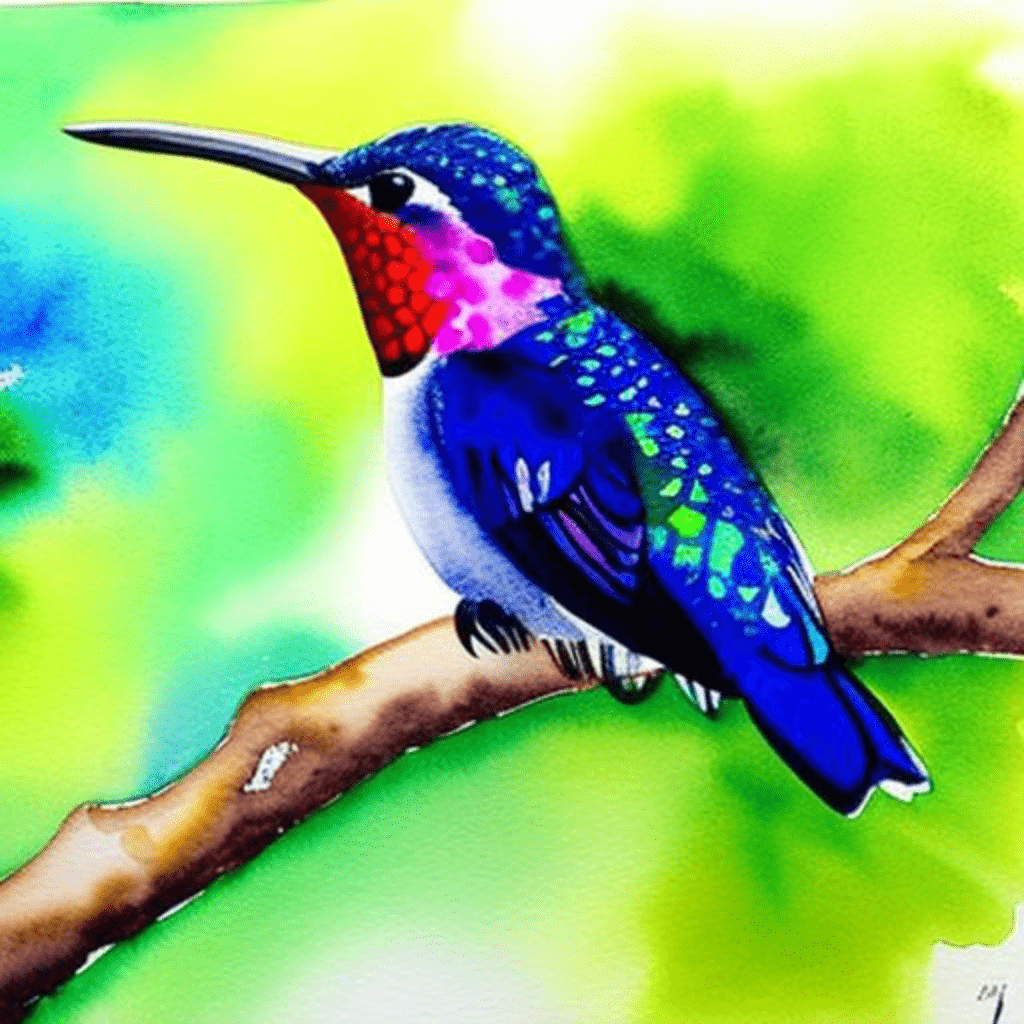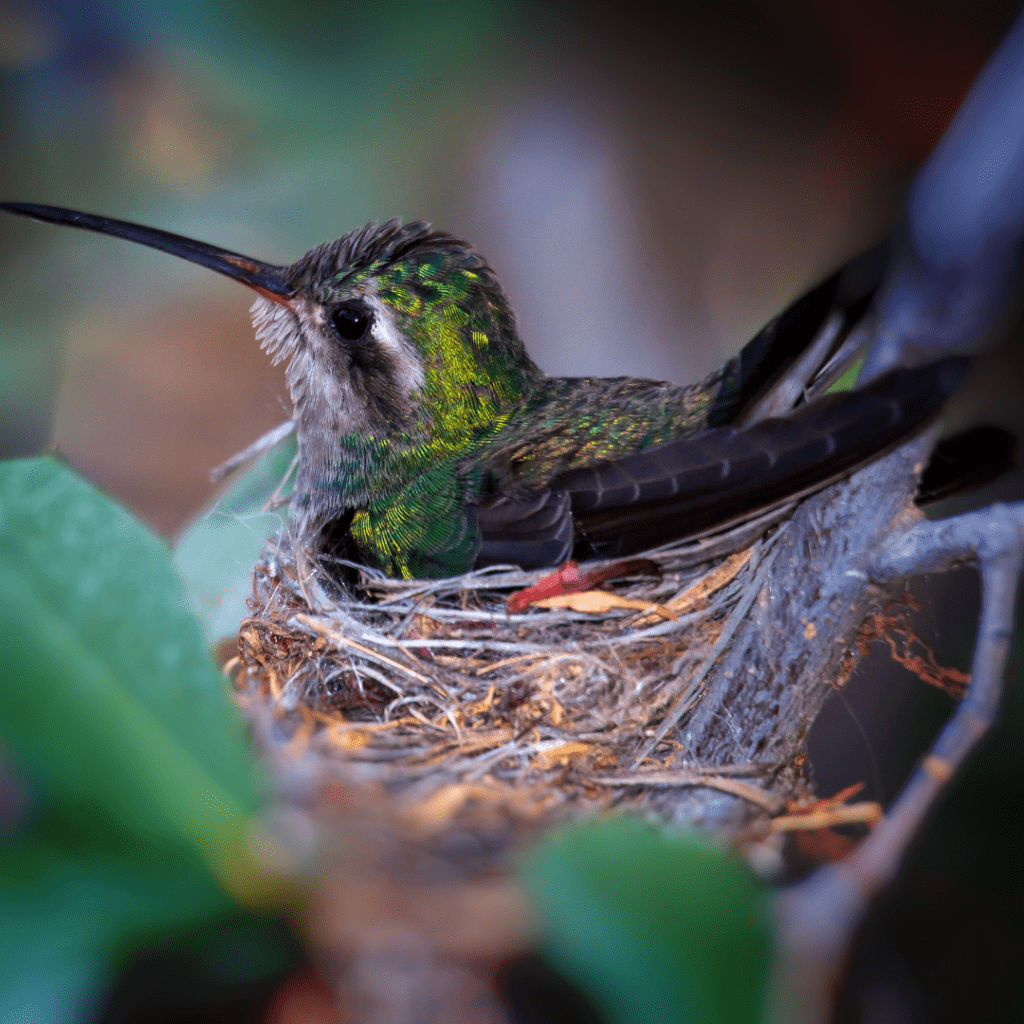Welcome to another exciting post from Happy Birding! Today, we’re going to explore the fascinating world of hummingbirds, specifically focusing on their sleeping habits. Hummingbirds are truly unique creatures with a multitude of intriguing characteristics, such as their tiny size, rapid wing movements, and ability to hover in place. In this post, we’ll delve into where these remarkable birds sleep, their sleep habits, and more. So, without further ado, let’s dive in!

Hummingbirds' Sleep Habits
How Much Sleep do Hummingbirds need?
Like most animals, hummingbirds require sleep to maintain their health and well-being. On average, hummingbirds sleep for about 10-12 hours per day, mostly during the night. Sleep allows them to restore their energy levels and is crucial for their survival.
Hummingbirds' Sleep Schedule
Hummingbirds are primarily diurnal creatures, meaning they are active during the day and rest at night. When night falls, these tiny birds enter a state known as torpor. Torpor is a deep, sleep-like state that allows hummingbirds to conserve energy by slowing down their metabolic rate and reducing their body temperature.
Hummingbirds' Brain Activity During Sleep
During sleep, hummingbirds exhibit a pattern of brain activity similar to that of humans and other animals, cycling through periods of REM (rapid eye movement) and non-REM sleep. REM sleep is associated with dreaming and is crucial for memory consolidation and learning, while non-REM sleep is essential for physical restoration.
Where Do Hummingbirds Sleep?
Natural habitats for hummingbirds
Hummingbirds can be found in a wide range of habitats, from tropical rainforests to mountain meadows. Their preferred habitats generally include areas with abundant flowers, as they rely on nectar for their primary food source.
Preferred sleeping locations
When it comes to choosing a spot to sleep, hummingbirds are quite particular. They prefer to sleep on thin branches or twigs, often opting for locations that are well-hidden and offer protection from predators and the elements. A well-concealed spot among dense foliage or under a canopy of leaves is an ideal choice for these small birds.
Factors that influence hummingbirds' sleeping locations
Several factors influence the choice of a sleeping location for hummingbirds. These include the availability of suitable perches, the presence of nearby food sources, and the level of protection from predators and harsh weather conditions. Additionally, individual preferences, such as the bird’s age, sex, and social status, may also play a role in selecting a sleeping spot.
Do Hummingbirds Sleep Upside Down?
Explanation of upside-down sleeping in birds
Some bird species, particularly parrots, are known to sleep upside down, gripping onto their perch with their feet while hanging with their heads downward. This behavior is thought to provide additional protection against predators, as it makes the birds less visible and harder to dislodge from their perches.
Research on hummingbirds and upside-down sleeping
Though upside-down sleeping has been observed in some bird species, it is generally not a common behavior in hummingbirds. Most hummingbirds sleep in an upright position, with their heads resting on their chests and their bodies parallel to the perch.
The frequency of hummingbirds sleeping upside down
While it is relatively rare, there have been occasional reports of hummingbirds sleeping upside down. These instances are likely exceptions rather than the rule, and further research is needed to understand the reasons behind this behavior.
Hummingbird Nests
Hummingbird nesting habits
Hummingbirds build tiny, cup-shaped nests to lay their eggs and raise their young. These nests are typically located on small branches or twigs and are well-hidden within the foliage of trees or shrubs. Adult hummingbirds may also use their nests as a sleeping location, particularly during the breeding season.

How nests provide a safe sleeping location for hummingbirds
Nests offer a secure and protected environment for hummingbirds to rest. They are typically constructed with soft materials, such as plant fibers, moss, and lichen, which provide insulation and cushioning. The nest’s small size and concealed location also make it difficult for predators to spot or access, ensuring the safety of both adult birds and their offspring.
Types of materials used to build hummingbird nests
Hummingbirds are resourceful builders, using a variety of materials to construct their nests. Common materials include plant fibers, moss, lichen, spider silk, and even small feathers. The use of spider silk is particularly interesting, as it provides flexibility and strength, allowing the nest to expand as the chicks grow.
Sleeping Alone vs. Sleeping in Groups
Advantages and disadvantages of sleeping alone
Sleeping alone offers several benefits for hummingbirds, such as reduced competition for resources and a lower risk of attracting predators due to decreased noise and movement. However, solitary sleepers may be more vulnerable to predation, as they lack the protection of a group.
Advantages and disadvantages of sleeping in groups
While hummingbirds typically sleep alone, they have been observed roosting in small groups on occasion. Group sleeping offers increased protection from predators, as the presence of multiple birds can deter potential threats. Additionally, group roosting may provide some degree of thermoregulation, helping the birds to conserve heat. However, sleeping in groups can also increase competition for resources and may make it more challenging to find suitable sleeping locations.
Factors that determine whether hummingbirds sleep alone or in groups
Several factors can influence whether hummingbirds sleep alone or in groups, including the availability of resources, environmental conditions, and individual preferences. For example, during times of abundant food supply, it may be more advantageous for hummingbirds to sleep in groups, as the benefits of protection outweigh the drawbacks of competition.
Sleeping and Migration
How hummingbirds' sleep patterns change during migration
During migration, hummingbirds must travel long distances, which can be physically demanding. As a result, their sleep patterns may change to accommodate their increased energy needs. Hummingbirds may sleep for shorter periods or enter a deeper state of torpor to conserve energy during migration.
How hummingbirds prepare for migration
To prepare for migration, hummingbirds must build up fat reserves to fuel their journey. This involves increasing their feeding rate and consuming more calories in the weeks leading up to migration. Additionally, they may adjust their sleeping habits to ensure they are well-rested and ready for the challenges ahead.
When do Hummingbirds Feed?
Explanation of hummingbirds' feeding habits
Hummingbirds primarily feed during daylight hours, visiting flowers to sip nectar and occasionally catching insects for protein. Their high metabolism requires them to consume a significant amount of food each day to maintain their energy levels.
Research on whether hummingbirds feed at night
Most research suggests that hummingbirds do not feed at night, as their primary food sources (flowers and insects) are less available during this time. Furthermore, their vision is not well-adapted for night-time foraging, making it difficult for them to locate food in the dark.
How hummingbirds' feeding habits may impact their sleep
Since hummingbirds do not typically feed at night, they rely on sleep and torpor to conserve energy and replenish their reserves. Adequate sleep is essential for maintaining their high metabolism and ensuring they have enough energy to forage and feed during the day.
Threats to Hummingbirds' Sleep
Human intervention and how it affects hummingbirds' sleep
Human activities, such as habitat destruction, pollution, and the introduction of invasive species, can have a significant impact on hummingbirds’ sleep. Loss of natural habitats can reduce the availability of suitable sleeping locations, forcing these birds to find alternative sites that may be less secure or provide less protection from predators and the elements. Additionally, artificial lighting from human developments can disrupt hummingbirds’ natural sleep patterns, causing disorientation and increased vulnerability to predation.
Predators and how they affect hummingbirds' sleep
Predators pose a constant threat to hummingbirds, especially while they are sleeping. Common predators include snakes, larger birds, and small mammals, such as raccoons or squirrels. To minimize the risk of predation, hummingbirds choose well-concealed sleeping locations and maintain a heightened level of alertness, even during sleep.
Hummingbirds' Sleep and Survival
Sleep is crucial for the survival of hummingbirds, as it allows them to conserve energy, restore their physical and mental well-being, and maintain their high metabolism. A lack of sleep can lead to reduced cognitive function, impaired immune response, and decreased energy levels, making it difficult for these birds to forage, evade predators, and perform other essential tasks.
How a lack of sleep affects hummingbirds' overall health
Sleep deprivation can have severe consequences for hummingbirds, potentially resulting in decreased reproductive success, increased vulnerability to disease and predation, and ultimately, reduced survival rates. As such, it is essential to protect and preserve hummingbirds’ natural habitats and minimize human-induced disturbances to ensure these fascinating creatures can thrive.
Frequently Asked Questions
Hummingbirds generally sleep for about 10-12 hours per day, mostly during the night, but they can sleep up to 18 hours!
Hummingbirds are diurnal creatures, meaning they are active during the day and sleep at night.
Hummingbirds sleep with their eyes closed, similar to most other animals.
No, hummingbirds cannot sleep while flying. They need to perch on a branch or twig to rest and enter a state of torpor.
Hummingbirds protect themselves by choosing well-hidden sleeping locations that offer protection from predators and the elements.
To attract hummingbirds, provide a diverse range of native flowering plants, maintain a clean and shallow water source, and offer nesting materials, such as small twigs and plant fibers. Additionally, minimize the use of pesticides and provide natural perches for them to rest.
No, hummingbirds primarily feed during daylight hours and do not typically feed at night.
While it is relatively rare, there have been occasional reports of hummingbirds sleeping upside down. However, most hummingbirds sleep in an upright position, with their heads resting on their chests and their bodies parallel to the perch.
Conclusion

James has always been an avid outdoorsman. Since a kid, he kept a journal of all the different birds and species he saw. Now he wants to share his passion with other birders with Happy Birding!
